Insurance never hurts: choosing an uninterruptible power supply for a heating pump
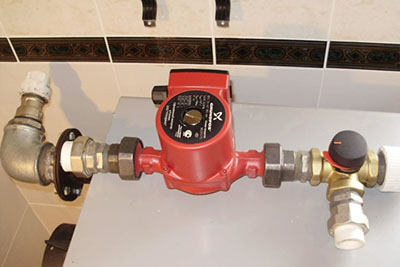
Operation of modern heating systems with forced circulation of the coolant directly depends on the voltage supply to the electrical circuit heating unit.
In the event of an accident in the power supply network, the heating pump and boiler automation are de-energized, which leads to the shutdown of the DHW boiler.
To protect autonomous DHW systems from sudden power outages, backup power sources are used. The most popular among owners of "autonomous" systems are uninterruptible power supplies (UPS).
Content
Advantages of UPS for powering circulation pumps
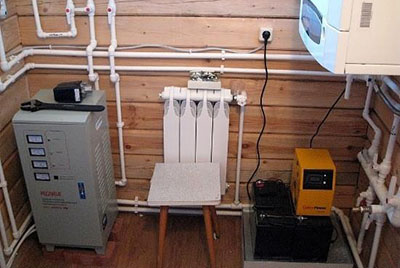
It's not hard to imagine what unpleasant consequences will cause freezing of water in the system in winter. Replacing burst pipes and radiators alone will cost owners a pretty penny.
Parametric failures in the electrical network can disable boiler electronics. voltage drop to 160–170 V (in single-phase units) during periods of peak energy consumption, amplitude surges and deviations of alternating current frequency of 50 Hz.
Design UPS or UPS (Uninterruptible Power Supply) is a device with a battery and a DC-AC converter (direct current → alternating current). The inversion process of the UPS is controlled by a microcontroller with a quartz generator.
What distinguishes UPS from other alternative sources is:
- compactness of devices, which allows us to produce products in tabletop/floor-standing versions;
- easy to connect and operate, quiet operation the entire model line of uninterruptible power supplies;
- relative cheapness most product items;
- basic protection of the electric motor and electronics of the autonomous DHW system;
- no maintenance costs during use;
- long service life (with battery recharging): from 3-5 years or more;
- minimum time pause or lack thereof when switching “backup power ↔ network”;
- almost sinusoidal output voltage with minimal distortion;
- the ability to change the frequency and voltage on the connected load.
Types of UPS

The uninterruptible power supply, depending on the supported options, provides the following functions:
- automatic switching for power supply from the battery in emergency situations;
- inversion of constant DC voltage (12 V) into the required alternating voltage (220 V) with frequency adjustment of 50 Hz;
- smoothing out voltage surges and filtering of network interference lasting 10–100 ms;
- stabilization of the “transit” network voltage in normal mode.
Reference! Switching the heating pump power supply to the battery, converting the voltage and filtering network interference are performed by all UPS/UPS. Voltage stabilization is performed only by devices equipped with a stabilizer block.
There are three types uninterruptible power supplies, which are also used to operate circulation pumps in heating systems.
Reserve
The simplest budget models only provide a switch to backup power. In normal mode the mains voltage goes directly to the boiler without stabilization, passing through one passive filter to protect against impulse interference.
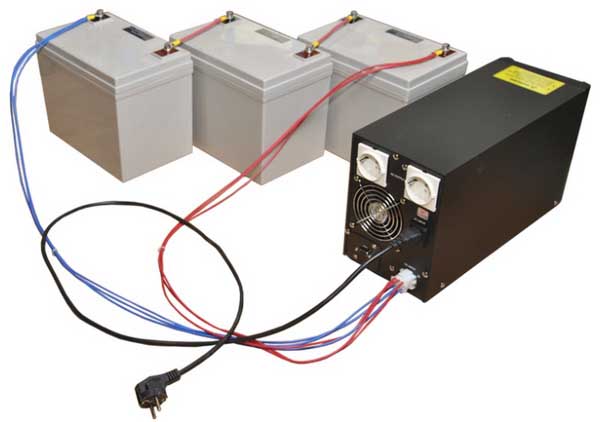
Photo 1. A backup budget UPS can only provide a transition to backup power supply.
In case of power failure, or if the parameters go beyond the range of values, The switch connects the standard battery in 4–12 ms. The battery's DC voltage is first fed to an electrical converter, where it becomes AC and is then increased to the required level. 220 V.
Linear interactive sources
These UPS are more advanced than the backup ones. They have a built-in stabilizer that corrects voltage fluctuations. within 25% of the nominal value. This allows you to work with fairly large voltage surges without connecting the battery to the process.
Technically, this problem is solved by installing an autotransformer that tracks the deviation of alternating voltage from a given value. In devices no correction for sinusoidal waveform network voltage.
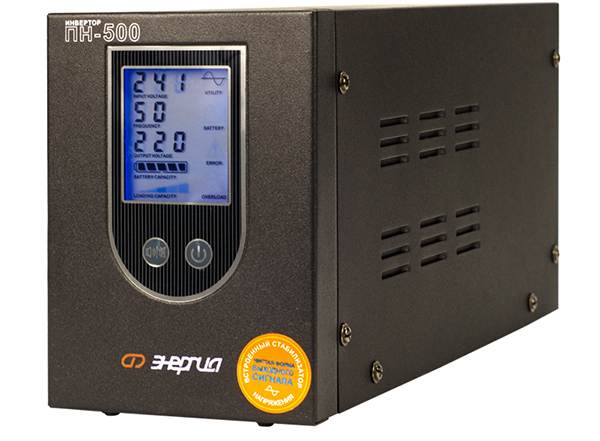
Photo 2. Line-interactive uninterruptible power supply with built-in stabilizer corrects voltage failures.
Inverter UPS
The principle of double inversion is implemented in the multi-component circuit of these devices. The serviced boiler equipment, regardless of the network state, always powered by battery.
In the absence of mains voltage, the usual process occurs DC→AC conversion Similar to a UPS backup, direct current is supplied to the battery terminals for recharging.
Inverter UPS reproduce stable electrical parameters, this type of device is ideal for powering heat pumps.
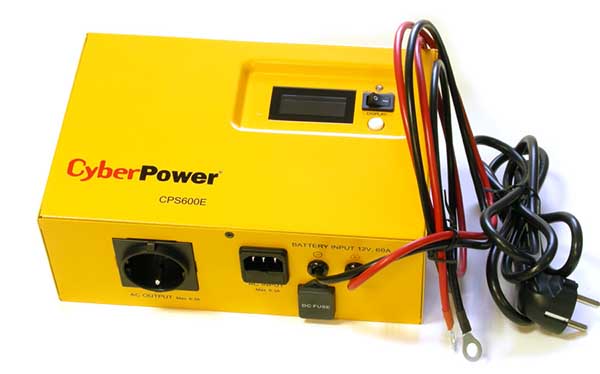
Photo 3. Inverter UPS from Cyber Power is used to power heating circulation pumps.
What kind of UPS is needed for a boiler?
The main purpose of the UPS is to provide electricity through the charge of the built-in battery. Desktop models of uninterruptible power supplies are common, but they are more suitable for computers.
Taking into account the provision of starting current, one battery charge will be enough for 30-40 minutes of continuous operation home hot water supply network.
To extend the battery life up to several hours, it is better to choose a UPS model that provides the ability to connect additional external batteries.
Attention! Equipment should be selected with LT (Long Time) marking. This means that external battery capacities are connected and controlled to it. Gel batteries are indispensable as additional batteries.
At the same time, uninterruptible power supplies improve the quality of the main power supply, preventing parameters from going beyond acceptable limits.
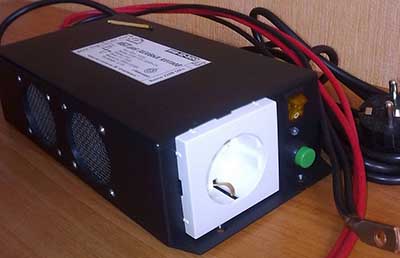
In our case, voltage stabilization is acceptable in the range of 220 V ± 5% while maintaining a frequency of 50± 0.2 Hz.
The difference between a UPS and a backup power source (generator, mini power plant) is that the device switches to battery mode in 3–10 milliseconds.
In the case of using UPS with double frequency conversion, there is no switching delay at all.
Using a device with such a minimum duration/absence of a “pause” will not lead to a failure in the operation of the automation or a stop of the DHW system pump.
Important! The boiler circulation pump is sensitive to the shape of the supplied voltage. It is necessary to select a device that inverts 12 V DC battery voltage to AC 220 V 50 Hz with a "pure" sine wave.
The latter requirement is specified by manufacturers in the equipment product data sheets. It means that the distortion factor of the sinusoidal current at the UPS output does not exceed 8%. Compliance with this condition will ensure silent operation of the pump and significantly will extend the service life of the electric motor.
How to make a UPS for a heating system with your own hands
Assemble your own uninterruptible power supply capable of within a few days The following guide will help you ensure the boiler is working properly.
Required set of components
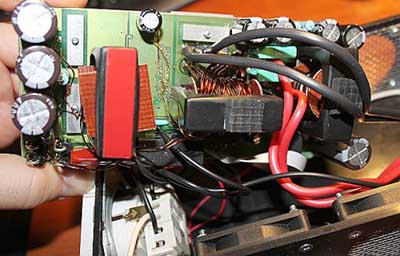
To design a UPS yourself, purchase the following ready-made modules and components:
- 2 car batteries, 12 V, 225 A∙h each;
- pulse power supply (PSU) 28.8 V at 50 A;
- 28.8 V inverter-converter with 310 V meander type output;
- power resonant filter of higher harmonics 310/220 V
- power cord with plug, pieces of insulated wire, connectors and sockets, housing.
Step-by-step assembly
All components are placed in the case, the components are connected in the following order:
- We connect the “+” and “-” of the pair of batteries with a jumper into a series battery, We connect the free terminals to the output of the pulse power supply.
- To these terminals connect the inverter, and we equip the power supply input with a wire and a plug for connection to the network.
- The inverter output is connected to the filter., at the output of which we obtain voltage 220 V 50 Hz with "pure" sine wave.
General recommendations for choosing the right UPS
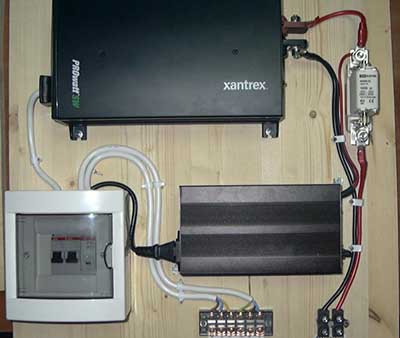
It should be taken into account that a gas boiler with one circulation pump and an electronic control unit requires up to 300 W power consumption. The UPS should be selected with the calculation that the rated power was not less than this value.
To calculate the continuous operation time of an uninterruptible power supply, the following formula is used:
Time (hours) = Battery voltage (V) x Battery capacity (Ah) / Electric power of the boiler (W). For example, for a device with a battery capacity of 150 A∙h and tension 12 V continuous operating time is equal to 6 hours: 12x150/300 = 6.
Useful video
The video explains which UPS is best to connect to a heating system pump.
Improving efficiency
In addition to monitoring and responding to voltage surges in the network, modern UPS provide 95–99% efficiency, the rest 1-5% power are spent on maintaining the operation of the UPS itself.
The traditional technology for saving electricity is considered to be bypassIn such designs, the network current, which does not require additional adjustment, is transmitted bypassing unused components. This increases the energy efficiency of UPS systems.








Comments